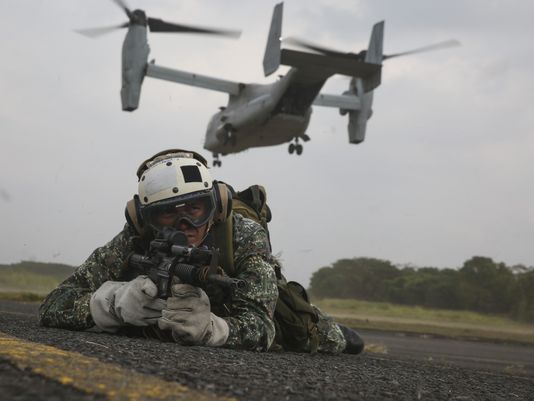The U.S. Military Is Moving into These 5 Bases in the Philippines
MILITARISM, 28 Mar 2016
Andrew Tilghman, Military Times – TRANSCEND Media Service
24 Mar 2016 – A new agreement between the United States and the Philippines clears the way for a new permanent American military presence across five bases that will support rotational deployments near the contested South China Sea.
The bases include:
Antonio Bautista Air Base. Located near the capital of the island province of Palawan, which is strategically located near the contested Spratly Islands in the South China Sea.
Basa Air Base. Located about 40 miles northwest of the Philippines’ capital, Manila, the air base was originally constructed by the U.S. Army Air Corps before the Second World War.
Fort Magsaysay. Located on the northern Island of Luzon, Fort Magsaysay is the largest military installation in the Philippines, and is one of the primary training areas of the Philippine Army.
Lumbia Air Base. Located on the southern island of Mindanao, the air base is connected to a civilian airport. Local media reports say construction of a new U.S. facility will begin soon.
Mactan-Benito Ebuen Air Base. Located on Mactan Island of the coast of Cebu in the central Philippines. It was originally built by the U.S. Air Force before the American pullout in the early 1990s.
The U.S. will be setting up “permanent logistics facilities to support rotational deployments,” said one defense official familiar with the agreement. The Pentagon is likely to invest heavily on construction projects to enhance capacity at those five bases.
The agreement was finalized Friday [18 Mar].
The rotational presence could, in effect, leave U.S. military assets and personnel on the ground in the Philippines for long periods if the missions are approved by the government in Manila.
The U.S. military presence in the Philippines, a former American colony, was once fiercely opposed by many Filipinos, partly because of notorious rowdy behavior and misconduct that was common among troops during the Vietnam era when the Philippines offered war fighters a respite from the combat zone. That led to the complete withdrawal of U.S. forces in the early 1990s.
But the Filipino government has recently sought new support from the United States as China has grown more aggressive in asserting territorial claims and conducting military-style operations near Filipino shores.
The list of bases surprised many analysts who expected it to include some of the former U.S. military outposts such as Naval Station Subic Bay and Naval Air Station Cubi Point, both strategically located on the northwest coast, or Clark Air Base near Manila. Those facilities were a backbone of logistics support during the Vietnam War.
China has stepped up its military activity in the region by claiming small uninhabited islands and even building new ones in the South China Sea off the western shores of the Philippines.
It’s likely that the American presence there will grow slowly because China’s activities have threatened the stability of the region, which includes vital trade routes for global economy.
“I suspect that it will ramp up slowly,” said Jan van Tol, a retired U.S. Navy captain and senior fellow at the Center for Strategic and Budgetary Assessments in Washington. “A suddenly much larger U.S. presence, even if just a rotational presence, that can be seen, certainty in Beijing, that this is a ratcheting up of a U.S.-Chinese competition in the South China Sea.”
Van Tol noted the Antonio Bautista Air Base on Palawan is very close to the Spratly Islands where China has made its controversial territorial claims. “That puts them much closer to the scene where the Chinese are using what we consider to be illegitimate activities,” he said.
The announcement of the five bases comes almost two years after President Obama visited the Philippines in 2014 and signed a new 10-year agreement with the former U.S colony. The future U.S. activity in the Philippines may include Marine Corps units rotating through the country like the ongoing mission in Darwin, Australia.
Go to Original – airforcetimes.com
DISCLAIMER: The statements, views and opinions expressed in pieces republished here are solely those of the authors and do not necessarily represent those of TMS. In accordance with title 17 U.S.C. section 107, this material is distributed without profit to those who have expressed a prior interest in receiving the included information for research and educational purposes. TMS has no affiliation whatsoever with the originator of this article nor is TMS endorsed or sponsored by the originator. “GO TO ORIGINAL” links are provided as a convenience to our readers and allow for verification of authenticity. However, as originating pages are often updated by their originating host sites, the versions posted may not match the versions our readers view when clicking the “GO TO ORIGINAL” links. This site contains copyrighted material the use of which has not always been specifically authorized by the copyright owner. We are making such material available in our efforts to advance understanding of environmental, political, human rights, economic, democracy, scientific, and social justice issues, etc. We believe this constitutes a ‘fair use’ of any such copyrighted material as provided for in section 107 of the US Copyright Law. In accordance with Title 17 U.S.C. Section 107, the material on this site is distributed without profit to those who have expressed a prior interest in receiving the included information for research and educational purposes. For more information go to: http://www.law.cornell.edu/uscode/17/107.shtml. If you wish to use copyrighted material from this site for purposes of your own that go beyond ‘fair use’, you must obtain permission from the copyright owner.

Any excuse for the USA to spread further into places which managed for a while to exert their independence. Poor Philippines!!!!